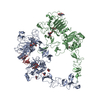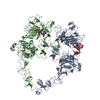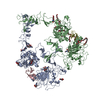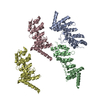登録情報 データベース : PDB / ID : 7sz7タイトル Cryo-EM structure of the extracellular module of the full-length EGFR bound to TGF-alpha. "tips-juxtaposed" conformation Epidermal growth factor receptor Transforming growth factor alpha キーワード / / / 機能・相同性 分子機能 ドメイン・相同性 構成要素
/ / / / / / / / / / / / / / / / / / / / / / / / / / / / / / / / / / / / / / / / / / / / / / / / / / / / / / / / / / / / / / / / / / / / / / / / / / / / / / / / / / / / / / / / / / / / / / / / / / / / / / / / / / / / / / / / / / / / / / / / / / / / / / / / / / / / / / / / / / / / / / / / / / 生物種 Homo sapiens (ヒト)手法 / / / 解像度 : 3.4 Å データ登録者 Huang, Y. / Ognjenovic, J. / Karandur, D. / Miller, K. / Merk, A. / Subramaniam, S. / Kuriyan, J. 資金援助 組織 認可番号 国 Canada Excellence Research Chair Award Howard Hughes Medical Institute (HHMI)
ジャーナル : Elife / 年 : 2021タイトル : A molecular mechanism for the generation of ligand-dependent differential outputs by the epidermal growth factor receptor.著者 : Yongjian Huang / Jana Ognjenovic / Deepti Karandur / Kate Miller / Alan Merk / Sriram Subramaniam / John Kuriyan / 要旨 : The epidermal growth factor receptor (EGFR) is a receptor tyrosine kinase that couples the binding of extracellular ligands, such as EGF and transforming growth factor-α (TGF-α), to the initiation ... The epidermal growth factor receptor (EGFR) is a receptor tyrosine kinase that couples the binding of extracellular ligands, such as EGF and transforming growth factor-α (TGF-α), to the initiation of intracellular signaling pathways. EGFR binds to EGF and TGF-α with similar affinity, but generates different signals from these ligands. To address the mechanistic basis of this phenomenon, we have carried out cryo-EM analyses of human EGFR bound to EGF and TGF-α. We show that the extracellular module adopts an ensemble of dimeric conformations when bound to either EGF or TGF-α. The two extreme states of this ensemble represent distinct ligand-bound quaternary structures in which the membrane-proximal tips of the extracellular module are either juxtaposed or separated. EGF and TGF-α differ in their ability to maintain the conformation with the membrane-proximal tips of the extracellular module separated, and this conformation is stabilized preferentially by an oncogenic EGFR mutation. Close proximity of the transmembrane helices at the junction with the extracellular module has been associated previously with increased EGFR activity. Our results show how EGFR can couple the binding of different ligands to differential modulation of this proximity, thereby suggesting a molecular mechanism for the generation of ligand-sensitive differential outputs in this receptor family. 履歴 登録 2021年11月25日 登録サイト / 処理サイト 改定 1.0 2021年12月15日 Provider / タイプ
 データを開く
データを開く 基本情報
基本情報 要素
要素 キーワード
キーワード 機能・相同性情報
機能・相同性情報 Homo sapiens (ヒト)
Homo sapiens (ヒト) データ登録者
データ登録者 カナダ,
カナダ,  米国, 2件
米国, 2件  引用
引用 ジャーナル: Elife / 年: 2021
ジャーナル: Elife / 年: 2021

 構造の表示
構造の表示 ムービービューア
ムービービューア Molmil
Molmil Jmol/JSmol
Jmol/JSmol ダウンロードとリンク
ダウンロードとリンク ダウンロード
ダウンロード 7sz7.cif.gz
7sz7.cif.gz PDBx/mmCIF形式
PDBx/mmCIF形式 pdb7sz7.ent.gz
pdb7sz7.ent.gz PDB形式
PDB形式 7sz7.json.gz
7sz7.json.gz PDBx/mmJSON形式
PDBx/mmJSON形式 その他のダウンロード
その他のダウンロード 7sz7_validation.pdf.gz
7sz7_validation.pdf.gz wwPDB検証レポート
wwPDB検証レポート 7sz7_full_validation.pdf.gz
7sz7_full_validation.pdf.gz 7sz7_validation.xml.gz
7sz7_validation.xml.gz 7sz7_validation.cif.gz
7sz7_validation.cif.gz https://data.pdbj.org/pub/pdb/validation_reports/sz/7sz7
https://data.pdbj.org/pub/pdb/validation_reports/sz/7sz7 ftp://data.pdbj.org/pub/pdb/validation_reports/sz/7sz7
ftp://data.pdbj.org/pub/pdb/validation_reports/sz/7sz7 リンク
リンク 集合体
集合体
 要素
要素 Homo sapiens (ヒト) / 遺伝子: EGFR, ERBB, ERBB1, HER1 / 発現宿主:
Homo sapiens (ヒト) / 遺伝子: EGFR, ERBB, ERBB1, HER1 / 発現宿主:  Homo sapiens (ヒト) / 参照: UniProt: P00533, receptor protein-tyrosine kinase
Homo sapiens (ヒト) / 参照: UniProt: P00533, receptor protein-tyrosine kinase Homo sapiens (ヒト) / 遺伝子: TGFA / 発現宿主:
Homo sapiens (ヒト) / 遺伝子: TGFA / 発現宿主: 
 試料調製
試料調製 Homo sapiens (ヒト)
Homo sapiens (ヒト) Homo sapiens (ヒト)
Homo sapiens (ヒト) 電子顕微鏡撮影
電子顕微鏡撮影
 FIELD EMISSION GUN / 加速電圧: 300 kV / 照射モード: FLOOD BEAM
FIELD EMISSION GUN / 加速電圧: 300 kV / 照射モード: FLOOD BEAM 解析
解析 ムービー
ムービー コントローラー
コントローラー





















 PDBj
PDBj













